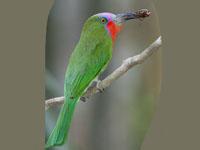Most bee-eater species are found in Africa and Asia, but some occur in southern Europe, Australia, and New Guinea. The largest is the blue-bearded bee-eater which has a length 31 to 35 cm and a weight 70 to 91 grams and the smallest is the little bee-eater which has a length of 16 to 17 cm and a weight of 13 to 19 grams. They are characterized by richly colored plumage, slender bodies, and usually elongated central tail feathers. All have long downturned bills and pointed wings, which give them a swallow-like appearance when seen from afar. Bee-eaters will fly up to 12 km from their colony, and stick closer to home if there is an adequate food supply. While they many types of flying insect, honey bees and their allies such as wasps predominate in their diet. Other favorite foods, but usually way do the list, are beetles, grasshoppers, and moths. Many species only catch prey that are on the wing and ignore flying insects once they land. Other species will sit on a perch and look both for flying prey on also for those on the ground. In either case, the bee-eater usually returns to their perch to have their meal. Before eating a beel, a bee-eater removes the sting by repeatedly hitting and rubbing the insect on a hard surface. During this process, pressure is applied to the insect thereby extracting most of the venom.
Many bee-eaters are colonial nesters with the larger species tending to have larger colonies. The smaller species are not colonial nesters. Like most of the Coraciiformes, bee-eaters are cavity nesters. Their cavities are burrows dug directly into the ground, river banks, or cliffs which are the preferred sites. Both parents dig the burrow, using their bill for excavation and their feet to move the material out of the burrow. Nests are usually used for just one breeding season. About 5 eggs are place at the end of the burrow on bare ground. Eggs are incubated for about 3 weeks with the male helping out during the day, but only the female incubates at night. The chicks fledge in about a month.
All but one of the bee-eater species have a conservation status of Least Concerned, and the blue-moustached bee-eater is only nearly threatened. One reason that almost all bee-eater species have stable populations is that their diet consists mostly of insects; their food source is not endangered. Another reason is that they nest in burrows which are most often located in the ground. Deforestation does not affect their home nearly as much as it does other species. It may affect the trees they perch on, but that behavior can be modified and species have learned that wires also make a fine perch. And finally, many of the colonial bee-eater species have "helpers" to make their life easier. These helpers are thought to most often be relatives - an offspring, parents that do not have a nest to tend this year, a widowed mother. The helpers particiapte in burrow excavation, incubation, feeding the young, and protecting the nest. These activities raise the odds that more chicks will survive which in turn helps the species prosper.
The bee-eater family Meropidae belongs to the Coraciiformes order, as do the kingfishers of family Alcedinidae, the motmots of family Momotidae, the rollers of families Brachypteraciidae and Coraciidae, and the todies of family Todidae.
Genus Meropogon - 1 species
Bee-eater,_Purple-bearded Meropogon forsteni
Description: The male purple-bearded bee-eater has green upperparts, wings, and tail. It has a purple head, "beard", and breast. The purple-bearded bee-eater has elongated central tail feathers which are commonly termed streamers, The lower belly is reddish-brown and the under-tail is chestnut. The female is similar but the fore-belly is reddish-brown, not purple. It is 25 to 26 cm (not including the streamers).
Range: Sulawesi of Indonesia.
Habitat: Opennings and clearings in forests, forest edges, farmland with large trees nearby.
Diet: Honeybees, bees, wasps, other airborne insects, beetles. Uses high perch to spot prey. Usually captures prey in the air, returns to perch, and then beats prey against the perch a few time.
Conservation status: Least Concern.
Image by: 1, 2) Francesco_VeronesiRange: Sulawesi of Indonesia.
Habitat: Opennings and clearings in forests, forest edges, farmland with large trees nearby.
Diet: Honeybees, bees, wasps, other airborne insects, beetles. Uses high perch to spot prey. Usually captures prey in the air, returns to perch, and then beats prey against the perch a few time.
Conservation status: Least Concern.
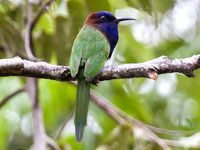
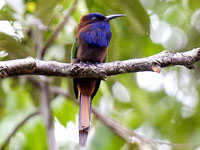
Genus Merops
Bee-eater,_Black Merops gularis
Description: The black bee-eater has mainly black plumage, a scarlet chin, scarlet throat, pale blue supercilium, and pale blue streaked breast. It is 20 cm long and weighs 25 to 34 grams.
Range: Central Africa.
Habitat: African tropical rainforest where it is found at the edges of the rainforest and in secondary woodland.
Diet: Airborne insects including honeybees, bees, wasps, ants. Also butterflies, dragonflies, beetles. Uses high perch to spot prey. Usually capture prey in the air, returns to perch, and then beats prey against the perch a few time.s.
Conservation status: Least Concern.
Image by: 1) P_Khoo 2) Ron_Knight 3) Francesco_Veronesi - Ghana 4) Nik_Borrow - GhanaRange: Central Africa.
Habitat: African tropical rainforest where it is found at the edges of the rainforest and in secondary woodland.
Diet: Airborne insects including honeybees, bees, wasps, ants. Also butterflies, dragonflies, beetles. Uses high perch to spot prey. Usually capture prey in the air, returns to perch, and then beats prey against the perch a few time.s.
Conservation status: Least Concern.
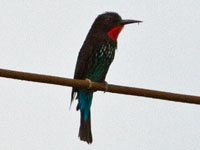

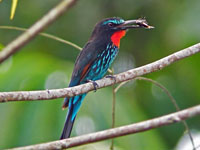
Bee-eater,_Black- headed Merops breweri
Description: The black-headed bee-eater has green upperparts, black head, buff underparts, rufous breast-band, and dark grey legs. In flight, the tail shows green feathers at the centre and rufous feathers at the edges. It is between 25 and 28 cm long (excluding streamers) and weighs 54 grams.
Range: Tropical central and west Africa.
Habitat: Open forests, forest clearings, forest edges, plantations. Prefers being near rivers and streams.
Diet: About half of food is made up of honeybees and related prey. Also beetles, dragonflies, butterflies, moths and cicadas. From a mid-story perch it darts out to catch an insect in flight.
Conservation status: Least Concern.
Image by: 1) Otto_Koehler 2) Nik_Borrow - GabonRange: Tropical central and west Africa.
Habitat: Open forests, forest clearings, forest edges, plantations. Prefers being near rivers and streams.
Diet: About half of food is made up of honeybees and related prey. Also beetles, dragonflies, butterflies, moths and cicadas. From a mid-story perch it darts out to catch an insect in flight.
Conservation status: Least Concern.
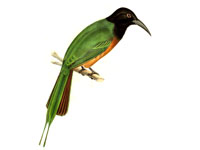
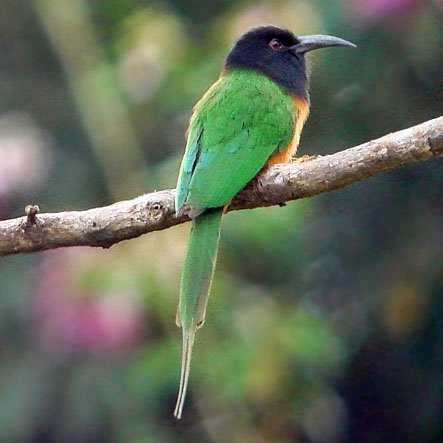
Bee-eater,_Blue-breasted Merops variegatus
Description: The blue-breasted bee-eater has green upperparts and crown, greenish-yellow underparts, yellow throat, blue or black gorget, black eye-line with blue above and white below. It has orange-red eyes. The tail, which has no streamers, has a subterminal black bar and is tipped with white. It is 18 to 21 cm long and weighs 20 to 26 grams. Their nest burrow is 45 to 75 cm long and they are not colonial breeders.
Range: Central Africa.
Habitat: Open wet habits such as reedy lake shores and savanna grass lands bordering the Congo basin.
Diet: Mainly bees. Also flies, beetles, grasshoppers, and butterflies.
Conservation status: Least Concern.
Image by: 1) Ron Knight 2) Fabrice_Stoger - Zambia 3) Nik_Borrow - EthiopiaRange: Central Africa.
Habitat: Open wet habits such as reedy lake shores and savanna grass lands bordering the Congo basin.
Diet: Mainly bees. Also flies, beetles, grasshoppers, and butterflies.
Conservation status: Least Concern.

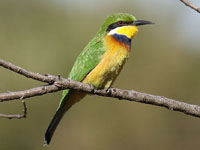
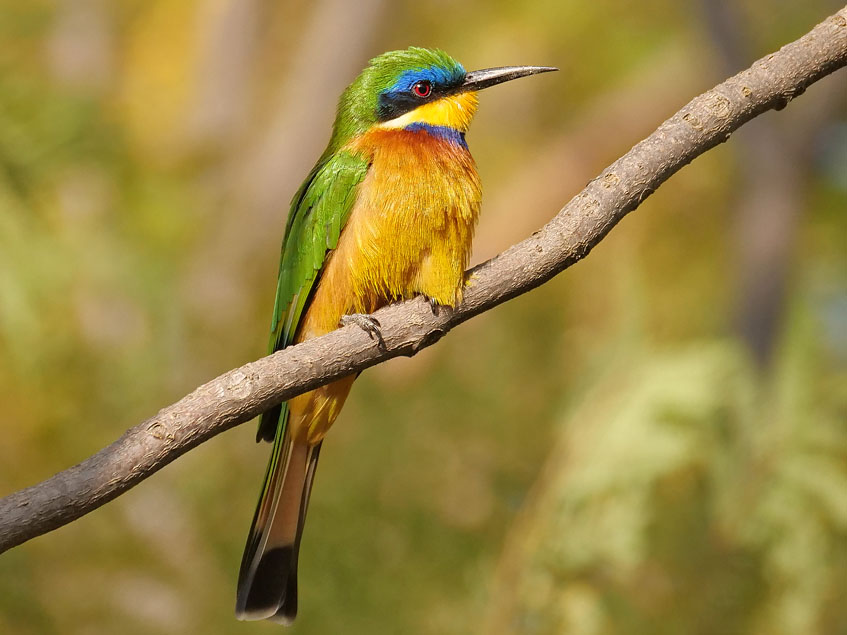
Bee-eater,_Blue-cheeked Merops persicus
Description: The blue-cheeked bee-eater has a light blue face with a black eye-line. The blue may be almost white. It has mainly green plumage, a black bill, and a yellow and brown throat. It does not have a forked tail like the similar swallow-tailed bee-eater. The blue-cheeked bee-eater is 31 cm long, not including its streamers, and weighs 38 to 56 grams. Its burrow is 1 to 3 m long, averages 6 white eggs, and incubates for 23 to 26 days. It usually nests in small colonies of up to 10 pairs.
Range: Africa, Asia.
Habitat: During breeding season it is found in dry and usually sandy areas. Other times it prefers greener areas, often near water.
Diet: More varied than most bee-eaters. Mainly bees and allies while breeding in Asia. While wintering in Africa dragonflies are sometime predominant. Also beetles, locusts.
Conservation status: Least Concern.
Image by: 1) Koshy Koshy 2) Charles_J_Sharp - Senegal 3) Nik_Borrow - Sierra Leone 4) Charles_J_Sharp - NamibiaRange: Africa, Asia.
Habitat: During breeding season it is found in dry and usually sandy areas. Other times it prefers greener areas, often near water.
Diet: More varied than most bee-eaters. Mainly bees and allies while breeding in Asia. While wintering in Africa dragonflies are sometime predominant. Also beetles, locusts.
Conservation status: Least Concern.

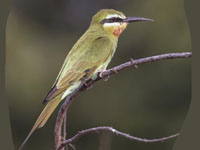
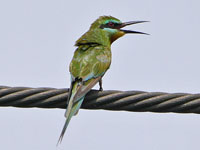

Bee-eater,_Blue-headed Merops muelleri
Description: The blue-headed bee-eater has brown upperparts and a red chin patch. It has blue head, tail, and underparts. The tail is square ended and does not have streamers. It is about 19 cm long and weighs 24 to 33 grams. The nesting burrow is relatively short, about 60 cm long.
Range: West and central Africa.
Habitat: Rainforest preferably clearings and forest edges.
Diet: Bees (especially honey bees), flies, beetles, butterflies. Almost all prey is taken on the wing then the bee-eater returns to the same perch.
Conservation status: Least Concern.
Image by: 1) Francesco_Veronesi - Kenya 2) Daniele_Colombo - Kenya Range: West and central Africa.
Habitat: Rainforest preferably clearings and forest edges.
Diet: Bees (especially honey bees), flies, beetles, butterflies. Almost all prey is taken on the wing then the bee-eater returns to the same perch.
Conservation status: Least Concern.
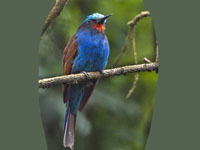
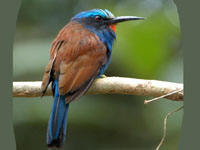
Bee-eater,_Blue-moustached Merops mentalis
Description: The blue-moustached bee-eater has mainly blue plumage with chestnut mantle and wings. There is a scarlet throat patch and insignificant streamers. It is 19 cm long and weighs 18 to 30 grams. The nesting burrow is relatively short, about 50 cm long.
Range: West-central Africa.
Habitat: Forests preferably clearings and forest edges.
Diet: Bees (especially honey bees), flies, beetles, butterflies. Almost all prey is taken on the wing then the bee-eater returns to the same perch.
Conservation status: The blue-moustached bee-eater is listed as Near Threatened due to habitat destruction via timbering.
Image by: 1) Francesco_Veronesi - Ghana 2, 3) Nik_Borrow - Ghana Range: West-central Africa.
Habitat: Forests preferably clearings and forest edges.
Diet: Bees (especially honey bees), flies, beetles, butterflies. Almost all prey is taken on the wing then the bee-eater returns to the same perch.
Conservation status: The blue-moustached bee-eater is listed as Near Threatened due to habitat destruction via timbering.
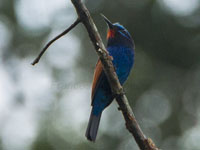
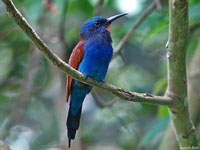

Bee-eater,_Blue-tailed Merops philippinus
Description: The blue-tailed bee-eater has mainly green plumage, a black eye-line with a little blue underneath, yellow and brown throat, blue tail and rump, and a black bill. It is 28 to 30 cm long (not including streamers) and weighs 29 to 43 grams. They nest, feed, and roost colonially.
Range: South and Southeast Asia.
Habitat: Not dense woods, but flexible otherwise. Prefers to be close to water.
Diet: Probably takes bees and dragonflies in roughly equal numbers. Also beetles, flys. moths.
Conservation status: Least Concern.
Image by: 1) Lip Kee - Malaysia 2) Charles_J_Sharp 3) Imrun_Shah - Pakistan 4) Ravi Vaidyanathan - MumbaiRange: South and Southeast Asia.
Habitat: Not dense woods, but flexible otherwise. Prefers to be close to water.
Diet: Probably takes bees and dragonflies in roughly equal numbers. Also beetles, flys. moths.
Conservation status: Least Concern.
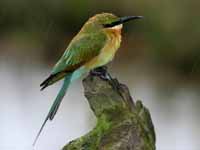
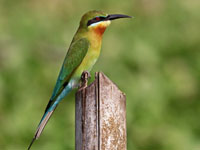


Bee-eater,_Blue-throated Merops viridis
Description: The blue-throated bee-eater has a reddish-brown mantle and crown. The throat, chin, cheeks, lower back and tail, are blue. Its streamer on the tail can be up to 9 cm long. The length without streamers is 21 to 23.5 cm and it weighs 34 to 41 grams. They nest colonially in tunnels that are usually 1 to 1.5 cm long. The average of 4 eggs hatch over a number of days. The younger ones usually die.
Range: East and southeast Asia.
Habitat: Forest canopy, clearing, dunes, pasture, mangroves.
Diet: Mainly bees, wasps, and dragonflies.
Conservation status: Least Concern.
Image by: 1) Charles_J_Sharp - Malaysia 2) Lip_Kee - Singapore 3) Hiyashi_Halso known as 4) LonelyShrimpRange: East and southeast Asia.
Habitat: Forest canopy, clearing, dunes, pasture, mangroves.
Diet: Mainly bees, wasps, and dragonflies.
Conservation status: Least Concern.
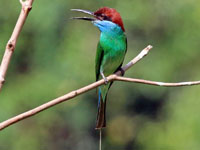

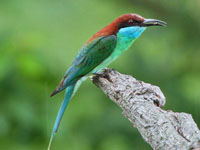
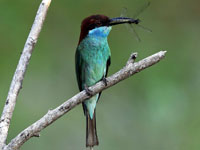
Bee-eater,_Bohm's Merops boehmi
Description: The Bohn's bee-eater has green upperparts, acinnamon crown, and yellow-orange throat. It has a wide black eye-line which is bordered below by a thin blue streak. The tail has a black tip and streamers up to 7 cm long. Its length is 16 cm and it weighs 14 to 20 grams. The pair creates a burrow 75 to 100 cm long and has 2 to 4 white eggs,
Range: DR Congo, Malawi, Mozambique, Tanzania, Zambia.
Habitat: Open forests, thickets, wooded fields. Prefers to be close to streams or rivers.
Diet: Bees, flies, grasshoppers, beetles, butterflies. Spots prey from a perch and then swoops towords the ground, or above the canopy.
Conservation status: Least Concern.
Image by: 1, 2) Francesco_Veronesi - Malawi 3) Nik Borrows - Malawi 4) DJ_CockburnRange: DR Congo, Malawi, Mozambique, Tanzania, Zambia.
Habitat: Open forests, thickets, wooded fields. Prefers to be close to streams or rivers.
Diet: Bees, flies, grasshoppers, beetles, butterflies. Spots prey from a perch and then swoops towords the ground, or above the canopy.
Conservation status: Least Concern.


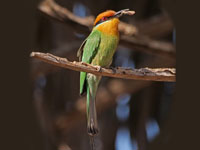
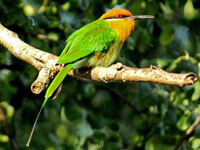
Bee-eater,_Chestnut-headed Merops leschenaulti
Description: The chestnut-headed bee-eater has green upperparts, yellow throat, black eye-stripe, blue rump, and black bill. The nape and crown are chestnut. It does not have tail streamers. It is 20 to 23 cm long and weighs 23 to 33 grams. It is a colonial breeder. The burrow in hard soil is about 50 cm long and up to 3 m in sandy soil.
Range: India east to Southeast Asia, including Thailand, Malaysia and Indonesia.
Habitat: Open spaces in forests, wooded country side, plantations.
Diet: Bees, dragonflies, butterflies, grasshoppers. Forages from a perch on a branch, wire, or fence.
Conservation status: Least Concern.
Image by: 1) JJ Harrison - Thailand 2) Ron Knight - Thailand 3) Mike_Prince 4) Ainus Range: India east to Southeast Asia, including Thailand, Malaysia and Indonesia.
Habitat: Open spaces in forests, wooded country side, plantations.
Diet: Bees, dragonflies, butterflies, grasshoppers. Forages from a perch on a branch, wire, or fence.
Conservation status: Least Concern.

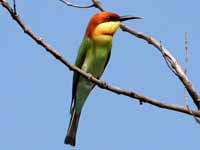
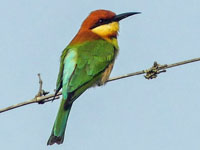
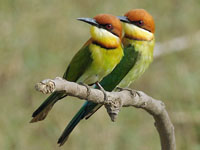
Bee-eater,_Cinnamon-chested Merops oreobates
Description: The cinnamon-chested bee-eater has a cinnamon-brown breast. It has green upperparts, head and tail. The tail, which has no streamers, has a black sub-terminal band and a white tip. It has a yellow throa, and white cheek patch. There is a black eye-line and a black gorget (collar line). It is 21 cm in length and weighs 25 to 29 grams. It is a colonial nester. The burrow is 60 to 70 m long and there are 2 to 3 eggs.
Range: Africa.
Habitat: Forests with clearing, forest edges, gardens and plantations.
Diet: Mainly honeybees. Also other bee relatives, beetles, dragonflies, butterflies. Hunts from a perch and returns to the perch with its prey.
Conservation status: Least Concern.
Image by: 1) Stephen Nawrocki - Rwanda 2) Lip Kee - Tanzania 3, 4) Charles_J_Sharp - KenyaRange: Africa.
Habitat: Forests with clearing, forest edges, gardens and plantations.
Diet: Mainly honeybees. Also other bee relatives, beetles, dragonflies, butterflies. Hunts from a perch and returns to the perch with its prey.
Conservation status: Least Concern.
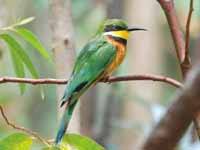
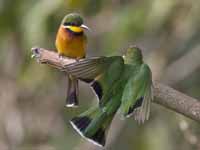

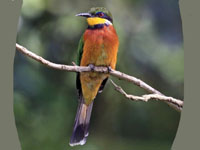
Bee-eater,_European Merops apiaster
Description: The European bee-eater has brown and yellow upperparts, green wings, yellow throat with a black gorget, greenish-blue underparts, and a black bill. It has an up to 2.5 cm tail streamer. It is a large bee-eater with its length of 28 cm and its weight 44 to 78 grams.
Range: Europe, Africa, Asia.
Habitat: Forests with open areas, forest edges, pasture, farm land with scattered trees.
Diet: Mainly bees and relatives. All day-flying insects between 5 mm and 50 mm long.
Conservation status: Least Concern.
Image by: 1) Arno Meintjes 2) Jose Arino - Spain Range: Europe, Africa, Asia.
Habitat: Forests with open areas, forest edges, pasture, farm land with scattered trees.
Diet: Mainly bees and relatives. All day-flying insects between 5 mm and 50 mm long.
Conservation status: Least Concern.
3) Agustin_Povedano - Spain 4) Cristiano Crolle - Isola della Cona, Italy 4) IRahulSharma - Germany
4) Male displaying to female.



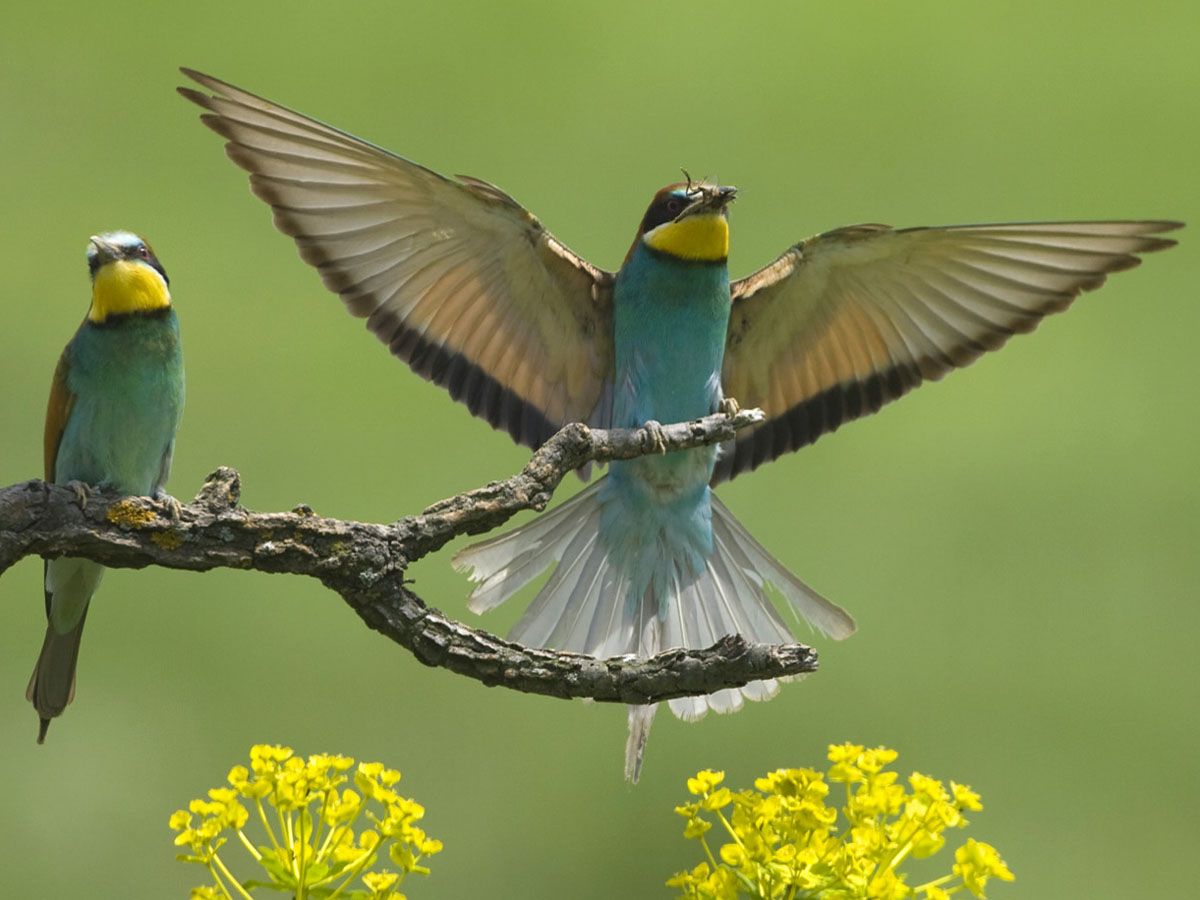
Bee-eater,_Green Merops orientalis
Description: The green bee-eater has mainly green plumage. It has a crown tinged with golden-rufous, some blue on the chin, black eye-line, and black elongated tail feathers. It is 16 to 18 cm long and weighs 14 to 27 grams. Some split the African and Arabian Peninsular populations into separate species
Range: Africa, Asia
Habitat: Arid woodland with scattered trees, semi-desert areas, farmland.
Diet: Mainly bees and relatives. Also termites, beetles, flies.
Conservation status: Least Concern.
Image by: 1) Anton_Croos Sri Lanka 2) J M Garg 3) Shantanu_Kuveskar - India 4) Sunil_Elias - IndiaRange: Africa, Asia
Habitat: Arid woodland with scattered trees, semi-desert areas, farmland.
Diet: Mainly bees and relatives. Also termites, beetles, flies.
Conservation status: Least Concern.
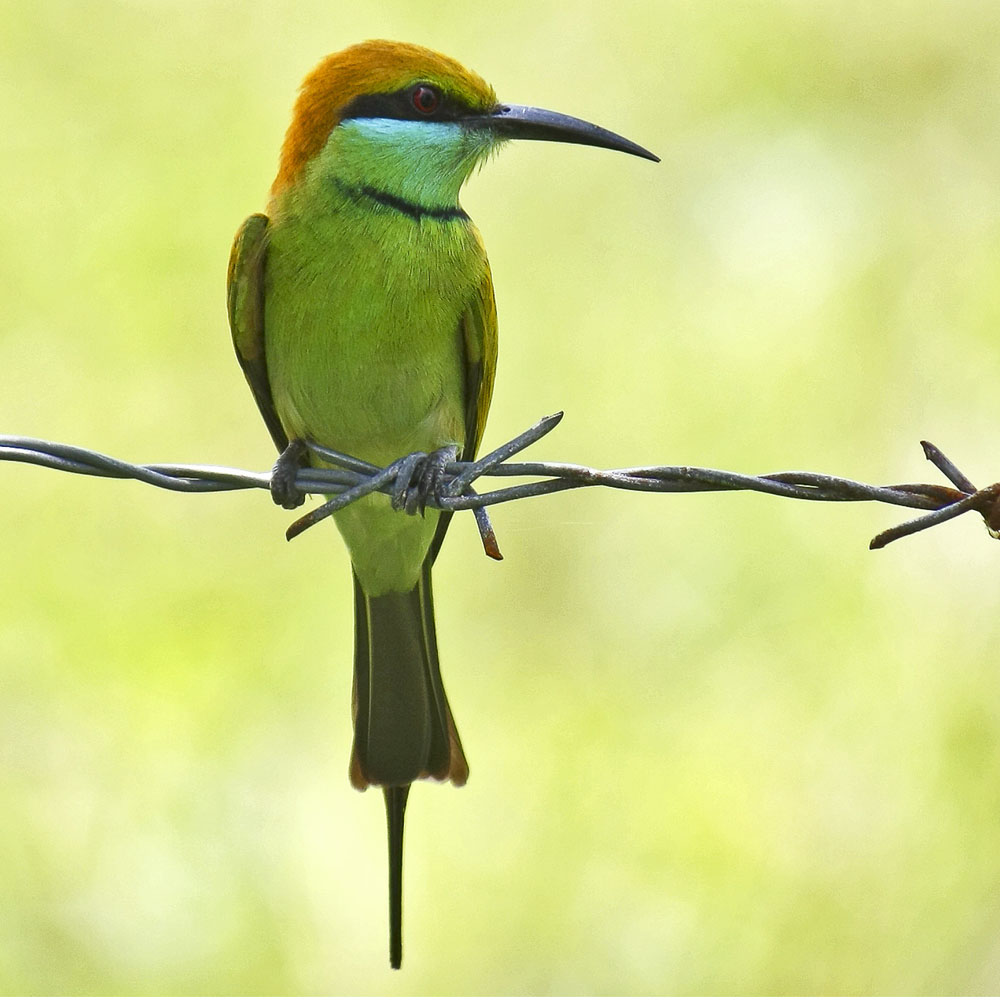

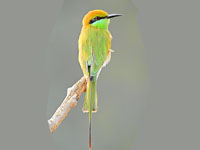
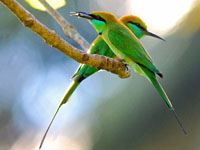
Bee-eater,_Little Merops pusillus
Description: The little bee-eater has green upperparts and buff yellow underparts. It has a wide black eye-line with sometimes a thin blue supercilium. The cheeks and throat are yellow with a black gorget below. There is no tail streamer. . It one of the smallest bee-eaters with a length of 16 to 17 cm and a weight of 13 to 19 grams. It excavates a burrow about 100 cm long, lays about 5 eggs, incubates 18 to 20 days, and fledges in 22 to 24 days. The similar cinnamon-chested bee-eater is larger than the little bee-eater and has a white cheek patch.
Range: Sub-Saharan Africa.
Habitat: Grassy areas near water, wooded savanna, grassy clearings in forests.
Diet: Mainly bees and their relatives; also spiders, butterflies, beetles. Forages mainly from low perch on a shrub or grass stem; also from perch up to 20 m high.
Conservation status: Least Concern.
Image by: 1) Steve Garvie 2) Charles_J_Sharp - Namibia
3) Dick Daniels- Nairobi National Park, Kenya
Range: Sub-Saharan Africa.
Habitat: Grassy areas near water, wooded savanna, grassy clearings in forests.
Diet: Mainly bees and their relatives; also spiders, butterflies, beetles. Forages mainly from low perch on a shrub or grass stem; also from perch up to 20 m high.
Conservation status: Least Concern.



Bee-eater,_Northern_Carmine Merops nubicus
Description: The northern carmine bee-eater has carmine upperparts, a dark greenish-blue head and throat, a wide black eye-line, and a turquoise belly. It is 24 to 27 cm long with streamers up to 10 cm. It weighs 34 to 59 grams. It nests in large colonies, excavates a 1 to 2 m burrow, and has 2 to 5 white eggs.
Range: Central Africa.
Habitat: Open areas with some trees.
Diet: Bees and relatives, grasshoppers, beetles, butterflies. Hunts from a tree or animal perch. Also hunts while gliding up to 100 meters above the ground.
Conservation status: Least Concern.
Image by: 1) Steve Garvie - Kenya 2) Bernard Dupont - Uganda 3) Viatour_Luc 4) Frans_VandewalleRange: Central Africa.
Habitat: Open areas with some trees.
Diet: Bees and relatives, grasshoppers, beetles, butterflies. Hunts from a tree or animal perch. Also hunts while gliding up to 100 meters above the ground.
Conservation status: Least Concern.
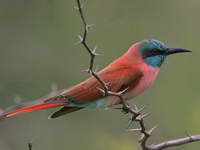
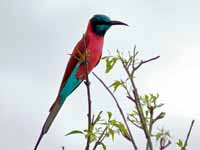
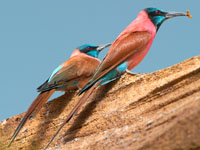
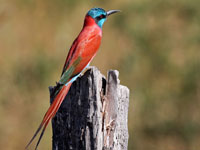
Bee-eater,_Olive Merops superciliosus
Description: The olive bee-eater, also known as Madagascar bee-eater, has mainly olive-green plumage. It has a black eye-line with white lines above and below. It has a length of 23 to 26 cm plus streamers up to 7 cm and weighs 40 to 48 grams. The olive bee-eater nests colonially, excavates burrows up to 2 meters long, and has 4 to 6 eggs.
Range: East Africa, Madagascar.
Habitat: Open country and also will hunt over fore4st canopy.
Diet: Bees and relative plus other flying insects.
Conservation status: Least Concern.
Range: East Africa, Madagascar.
Habitat: Open country and also will hunt over fore4st canopy.
Diet: Bees and relative plus other flying insects.
Conservation status: Least Concern.
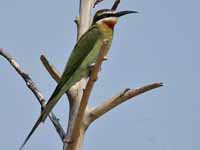
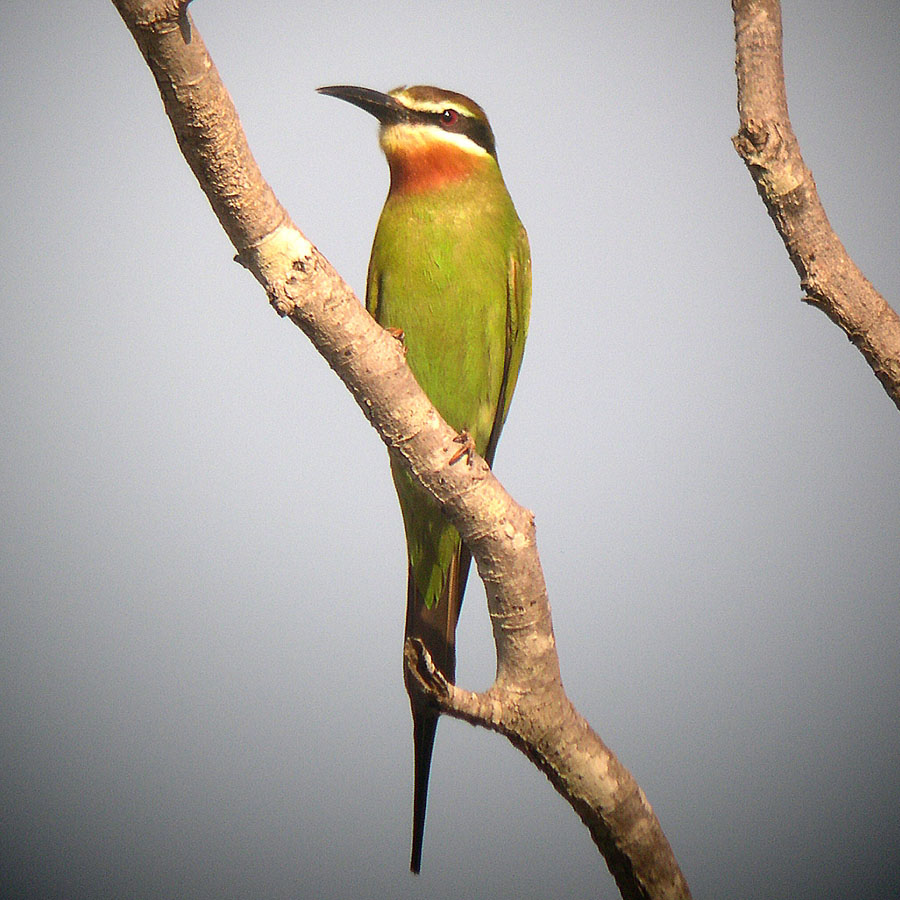
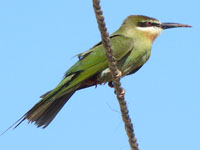
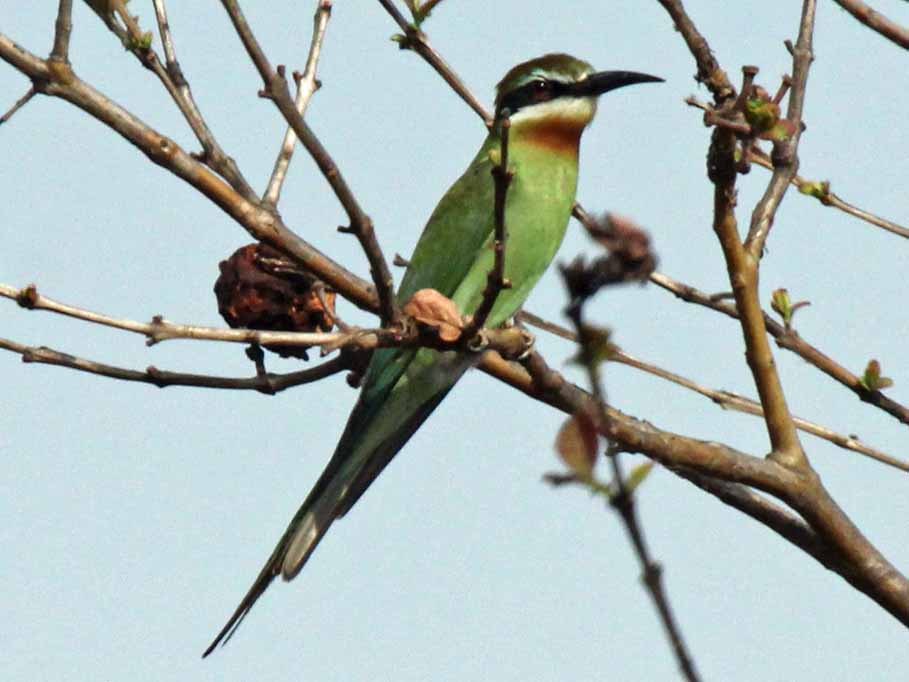
Bee-eater,_Rainbow Merops ornatus
Description: The rainbow bee-eater has a green upper back, and wings. The lower back and under tail coverts are blue. It has a yellow crown, throat, and breast. There is a black tail, black eye-lines, and red eyes. It is 19 to 21 cm long plus has streamers up to 7 cm and weighs 20 to 33 grams. They excavate burrows averaging 1.5 meters, lay about 4 eggs, and incubate for 21 days. Rainbow bee-eaters nest colonially and a pair often has helpers during excavation and incubation.
Range: Australia. This is the only species of this genus found in Australia.
Habitat: Open country with trees available.
Diet: Mainly bees and relatives; also beetles, dragonflies, flies. Spots prey from a perch which it captures on the wing.
Conservation status: Least Concern.
Image by: 1) birdsaspoetry 2)
David Cook 3) patrickkavanagh 4) JJ_Harrison Range: Australia. This is the only species of this genus found in Australia.
Habitat: Open country with trees available.
Diet: Mainly bees and relatives; also beetles, dragonflies, flies. Spots prey from a perch which it captures on the wing.
Conservation status: Least Concern.

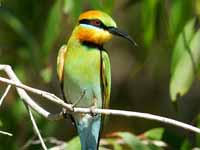

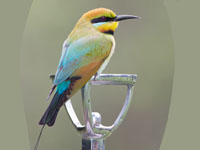
Bee-eater,_Red-throated Merops bulocki
Description: The red-throated bee-eater has green upperparts with a red chin and throat. A few have a yellow throat instead of a red one. It has buff hind-neck, breast, and underparts. The under-tail coverts and thighs are bright blue, It has a black eye-stripe, It is 22 cm long, weighs 21 to 28 grams and has no tail streamers. The red-throated bee-eater is a colonial nester, It excavates a burrow about 80 cm long, lays about 3 eggs, incubates 19 to 21 days, Helpers, usually relatives, may participate in the excavation.
Range: Central Africa.
Habitat: Open areas with trees and often streams or rivers near by.
Diet: Bees and relatives, flying ants, beetles, dragonflies, moths, grasshoppers. Looks for prey from a perc,.cCatches it in mid-air and carries it back to the perch.
Conservation status: Least Concern.
Image by: 1, 3) Frans_Vandewalle - Senegal, Gambia 2) Nik_Borrow - Uganda 4) Allan_Hopkins - Gambia Range: Central Africa.
Habitat: Open areas with trees and often streams or rivers near by.
Diet: Bees and relatives, flying ants, beetles, dragonflies, moths, grasshoppers. Looks for prey from a perc,.cCatches it in mid-air and carries it back to the perch.
Conservation status: Least Concern.
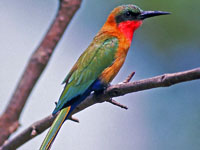


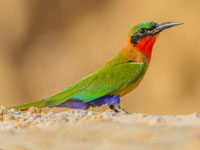
Bee-eater,_Rosy Merops malimbicus
Description: The rosy bee-eater has slate-grey upperparts, a dark-grey crown and forehead, black mask, white chin and throat with rosy patch, and pink underparts. It is 22 to 25 cm long, has streamers up to 5 cm, and weighs about 45 grams. It nests in huge colonies, excavates burrows about 200 cm long, and has 2 eggs.
Range: West-central Africa.
Habitat: Nests colonially on beaches and sandbars exposed by falling water level.
Diet: Mainly flying ants; also bees and their relatives, dragonflies, grasshoppers, flies, beetles. They are the most aerial of the bee-eaters. They mainly search for prey while flying, but will also search from a perch.
Conservation status: Least Concern.
Image by: 1) Francesco_Veronesi - Ghana 2) Nik_Borrow - GhanaRange: West-central Africa.
Habitat: Nests colonially on beaches and sandbars exposed by falling water level.
Diet: Mainly flying ants; also bees and their relatives, dragonflies, grasshoppers, flies, beetles. They are the most aerial of the bee-eaters. They mainly search for prey while flying, but will also search from a perch.
Conservation status: Least Concern.
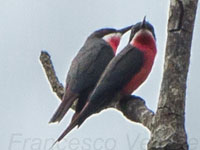
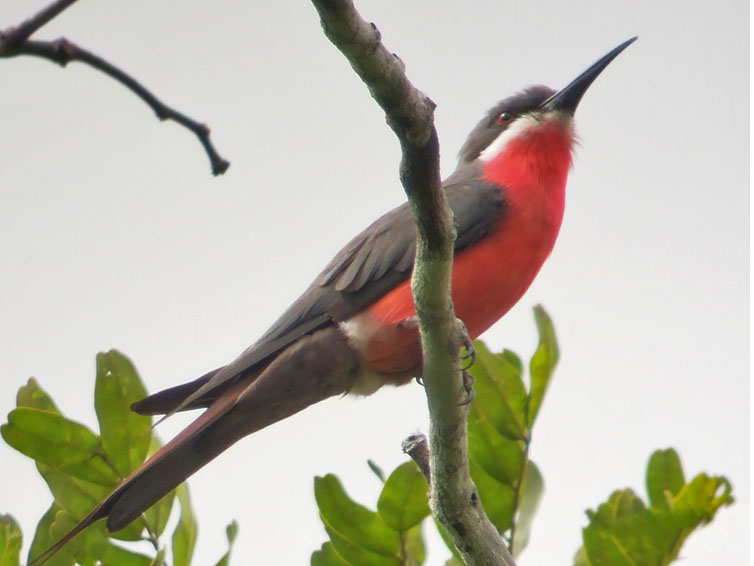
Bee-eater,_Somali Merops revoilii
Description: The Somali bee-eater has green upperparts, blue lower back and rump, bluish-green tail, glossy green crown, blue supercilium, white chin and throat, black bill, and cinnamon-buff underparts. The Somali bee-eater is one of the smallest bee-eater of the genus having a length of 16 to 18 cm and weighing 12 to 15 grams.
Range: Ethiopia, Kenya, Saudi Arabia, Somalia, Tanzania.
Habitat: Open scrub and grasslands with scattered bushes.
Diet: Small insects which it catches via short flights from a perch.
Conservation status: Least Concern.
Image by: 1) Steve_Garvie - Kenya 2, 3) Nik_Borrow - Kenya, Ethiopia 4) Francesco VeronesiRange: Ethiopia, Kenya, Saudi Arabia, Somalia, Tanzania.
Habitat: Open scrub and grasslands with scattered bushes.
Diet: Small insects which it catches via short flights from a perch.
Conservation status: Least Concern.




Bee-eater,_Southern_Carmine Merops nubicoides
Description: The southern carmine bee-eater has mainly pinkish-red upperparts, pale underparts, a blue crown and rump, and a wide black eye-line. It is 24 to 27 cm long with streamers up to 12 cm. It weights 66 to 66 grams. It nests in large colonies, excavates a 1 to 2 m burrow, and has 2 to 5 white eggs. It is similar to the northern carmine bee-eater, but the chin is much paler and the southern weighs more. Their ranges do not overlap much.
Range: Africa.
Habitat: Open areas with some trees.
Diet: Bees and relatives, grasshoppers, beetles, butterflies.
Conservation status: Least Concern.
Image by: 1) Lip_Kee - Botswana 2) Arno
3) Bernard_Dupont - South Africa 4) Martin_Heigan Range: Africa.
Habitat: Open areas with some trees.
Diet: Bees and relatives, grasshoppers, beetles, butterflies.
Conservation status: Least Concern.
1) Adult Ileft) and juvenile
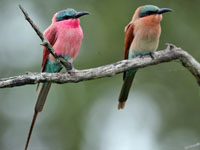

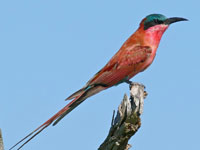
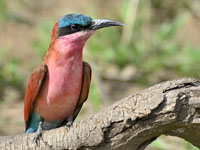
Bee-eater,_Swallow-tailed Merops hirundineus
Description: The swallow-tailed bee-eater has a blue forked tail, blue cheeks and collar, blue-green underparts, a black eye-stripe, and a black bill. It does not have tail streamers. It is 23 cm long and weighs 18 to 29 grams.
Range: Sub-Saharan Africa.
Habitat: Somewhat more wooded country than most bee-eaters.
Diet: Bees and relatives, flies, beetles, grasshoppers, butterflies.
Conservation status: Least Concern.
Image by: 1) Dick Daniels - specimen in Nairobi National Museum, Kenya 1) Nik Borrows - MalawiRange: Sub-Saharan Africa.
Habitat: Somewhat more wooded country than most bee-eaters.
Diet: Bees and relatives, flies, beetles, grasshoppers, butterflies.
Conservation status: Least Concern.
2) Frank Vassen - Namibia 3) Derek_Keats - South Africa 4) Charles_J_Sharp - South Africa
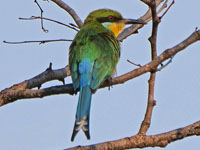
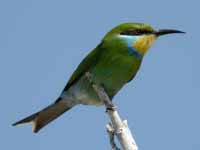

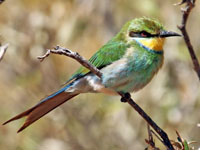
Bee-eater,_White-fronted Merops bullockoides
Description: The white-fronted bee-eater has green upperparts, and cinnamon underparts. It has a white forehead and chin below which is a red throat. It is 23 cm long and weighs 28 to 38 grams. They are colonial nesters. Helpers aid in excavating the 1 to 2 meter long burrow, incubating the eggs, feeding the chicks, and defending the nest. The helpers are usually related to the parents.
Range: Sub-equatorial Africa.
Habitat: Woodlands along rivers and open country.
Diet: Mainly bees and their allies. Also beetles, bugs, flies, dragonflies, butterflies, grasshoppers.
Conservation status: Least Concern.
Image by: 1) Luc Viatour 2) Dick Daniels - Kenya 3) Steve Garvie - Kenya 4) Ian_White - Botswana Range: Sub-equatorial Africa.
Habitat: Woodlands along rivers and open country.
Diet: Mainly bees and their allies. Also beetles, bugs, flies, dragonflies, butterflies, grasshoppers.
Conservation status: Least Concern.
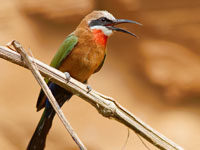
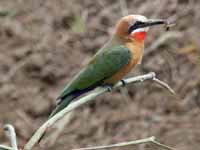
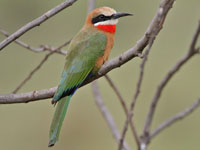
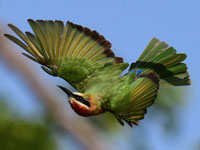
Bee-eater,_White-throated Merops albicollis
Description: The white-throated bee-eater has pale green upperparts and pale green underparts shading to pale blue on the breast. It has a black-and-white striped head, white throat, black upper breast band, red eye, black bill. It is 19 to 21 cm long with up to 12 cm tail streamers and weighs between 20 and 28 grams. They nest colonially in sandy banks or open flat areas. Relatives help in the excavation of 1 to 2 meter burrow, incubation of the eggs, and feeding the young. The male has longer tail feathers than female.
Range: Sub-Saharan Africa.
Habitat: Breeds in sparsely vegetated areas. WInters in forest clearings, treed savannas, farmland.
Diet: Mainly bees and their allies. Also beetles, flies, dragonflies, moths, grasshoppers. Searches for prey from a perch then dashes to catch it in the air or glides to ground if the prey is located there.
Conservation status: Least Concern.
Image by: 1) Francesco_Veronesi - Kenya 2) Dave_Curtis - Kenya 3) Charles_J_Sharp - Uganda 4) Diana_Robinson - Kenya Range: Sub-Saharan Africa.
Habitat: Breeds in sparsely vegetated areas. WInters in forest clearings, treed savannas, farmland.
Diet: Mainly bees and their allies. Also beetles, flies, dragonflies, moths, grasshoppers. Searches for prey from a perch then dashes to catch it in the air or glides to ground if the prey is located there.
Conservation status: Least Concern.
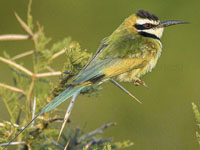
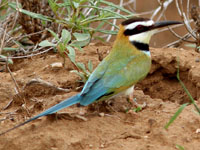

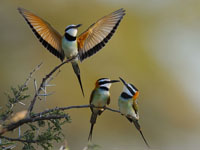
Genus Nyctyornis
These are large bee-eaters, predominantly green, with a face color as indicated by the specie's name. This color extends to the slightly hanging throat feathers which form the "beard".
Bee-eater,_Blue-bearded Nyctyornis athertoni
Description: The blue-bearded bee-eater has green upperparts plus olive underparts with streaks of blue or green. It has a pale blue forehead. The blue throat feathers are broad and long producing a beard-like appearance. The square ended tail does not have streamers. This is a large bee-eater with a length 31 to 35 cm and a weight 70 to 91 grams. They are not colonial nesters and excavate burrows 1.3 to 3 meters long.
Range: Indian subcontinent, southeast Asia.
Habitat: Moist forests, forest clearings, gardens with nearby trees.
Diet: Mainly bees and allies. Also beetles, dragonflies.
Conservation status: Least Concern.
Image by: 2) JJ_Harrison - Thailand 3) Jason_Thompson - Thailand 4) Vijay_Ismavel - India 5) Chesano - Bangalore Range: Indian subcontinent, southeast Asia.
Habitat: Moist forests, forest clearings, gardens with nearby trees.
Diet: Mainly bees and allies. Also beetles, dragonflies.
Conservation status: Least Concern.
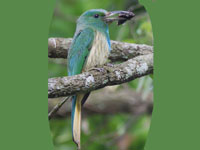



Bee-eater,_Red-bearded Nyctyornis amictus
Description: The red-bearded bee-eater has red coloration of its face which extends to hanging throat feathers that form the "beard". Its upperparts are green and underparts are yellow with the tail having a black terminal band. The square ended tail does not have streamers. This is a large bee-eater with a length 27 to 31 cm and a weight 61 to 70 grams. They are not colonial nesters and excavate burrows 1 to 2 meters long.
Range: Southeast Asia.
Habitat: Lowland forests especially new water, forest clearings, gardens with nearby trees.
Diet: Mainly bees and allies; also beetles, crickets, ants.
Conservation status: Least Concern.
Image by: 1) Jason_Thompson - Thailand 2) JJ_Harrison - Thailand 3) Lip_Kee - Malaysia 4) Francesco_Veronesi - ThailandRange: Southeast Asia.
Habitat: Lowland forests especially new water, forest clearings, gardens with nearby trees.
Diet: Mainly bees and allies; also beetles, crickets, ants.
Conservation status: Least Concern.

